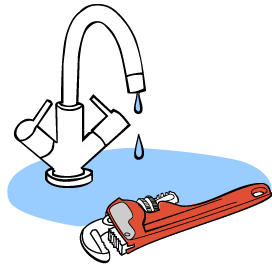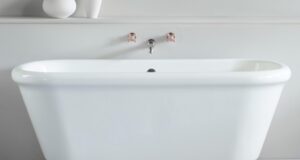
Need some help with plumbing? Got a leak and not sure what to do? Don’t panic – here’s some quick how to handle various different sorts of plumbing emergencies.
Plumbing emergencies can happen in any home at any time. They’re normally a pain, because you can be left without water or gas (or worse -without drainage) for long periods of time. While there some minor problems you can deal with yourself, in most cases plumbing emergencies need to be dealt with by a licensed plumber. Having said that, though, there are steps you can take to help assess the problem, and limit the damage before the plumber arrives.

Here’s how to deal with different types of plumbing emergencies:
- Toilet emergencies
- Leaking taps or pipes
- Clogged drains
- Hot water problems
- Banging pipes
- Leaking roof
Toilet emergencies
Toilet emergencies normally involve a clogged toilet, a leaking or broken toilet, or a toilet that won’t stop running or flushing. When contacting a plumber, explain the problem as clearly as possible. Reputable plumbers will visit your home before making an estimate or starting the job. However, you can make the plumber’s job easier if you can clearly determine what the problem is and relay that over the phone. Diagnosing problems first will often save a lot of money, and depending on the problem you may find that you can fix it yourself.
- Clogged toilet
Even if this is something you’ve never experienced, you’ll appreciate that things can turn very nasty when this happens. In some cases, a manual plunger can solve the problem. The first thing to do when the toilet clogs is to STOP FLUSHING. Next, read and follow the steps outlined in this article about how to unblock a toilet. If all else fails or if your toilet is threatening to overflow, call a plumber immediately.
- Toilet leak
First, ensure that it’s the toilet that’s leaking – check your shower stall or bathtub too to make sure you understand where the leak is coming from. In most cases you’ll be able to turn a tap behind the toilet to stop the flow of water to it, and this should be your first course of action to prevent the situation from worsening. Once you’ve done this, call a plumber.
- Constantly running toilet
This is usually caused when the valve that lets the water into the bowl from the tank isn’t sealed properly. To find a leaky valve place a few drops of food colouring in the tank to see if it is leaking in-between flushes. The colour will seep out where the leak is occurring. If there is a leak, you need a new seal or it might be just as easy and cheaper to replace the entire valve.
Leaking taps or pipes
Leaking can occur in just about any fixture or fitting in the house, and usually indicates the presence of a broken or missing o-rings or a loose pipe. If you do have a leak, you should turn the water off at the water meter, unless there is a stop cock or mini valve on the connection between the water supply and tap, in which case you can turn that off first to try and isolate the problem. Your water meter is normally located towards the front of your property, often in the left or right hand corner of the yard.

- Leaky taps
If it’s a small leak from a tap, you may be able to deal with it yourself. The first point of call is to remove the tap spout and spindle and check the o-rings and washer. An O ring is a gasket. It is a flat ring made of either rubber, metal, or plastic. The gasket is used to seal joints against high pressure leaks. Taking care of minor leaks before they become worse is recommended to avoid future problems. If your tap still leaks, call a plumber to do a routine inspection. The internal body of your tap where your spindle meets with it may have had the surface of the brass become rough, in which case it will need to be smoothed over with a re-seating tool.
- Mains or pipe leak
If you suspect a pipe has burst or is leaking anywhere on your property, immediately turn off the water at the meter to prevent further leakage, and call a plumber. The valve for the mains water is located near the main water supply pipes.
- You know if you have a burst pipe if:
- The pressure in your water tank suddenly decreases
- You find a huge puddle where there wasn’t one before
- Your water bill suddenly skyrockets for no apparent reason
Another way to tell if you have a leak is to take a reading from your water meter, and then stop using any water in the house for several hours (don’t even flushing the toilet). If you check the meter again and it shows that water has been consumed, it’s possible you have a leak
Clogged drains
Your drains can become clogged with a wide range of things – most commonly hair. Plumbers are constantly removing hair and grease, but sometimes your kids may have thrown some toys down a drain. This article features a step-by-step guide on how to unblock a drain.
Clogs often happen outside the home. Make sure your drain cover is securely in place to stop tennis and other balls blocking the pipes. Cans can also roll, but more often than not they probably find their way into drains when people throw them in there. Regularly check your outside drains for blockages.
Tree roots are also a major cause of blocked drains. Tree roots can cause significant damage and lead to recurring blockages. Keep this in mind when choosing where to plant trees.
Hot water emergencies
Where would we be without hot water? Without it there’s no hot showers… the situation doesn’t bear thinking about. Sadly, problems with hot water are common and fixing those problems can be quite expensive, unless it’s just that the pilot light that has gone out and needs to be fired up again. Here’s an excellent guide on how to deal with hot water emergencies.
Banging pipes
The problem with banging pipes is you can’t tell where the problem is coming from, unless it’s from an external pipe. In some cases, it might be that there’s an air pocket trapped in a pipe somewhere. Try turning all of the taps in your house on at once, to full, for a thirty seconds or so. If you’re lucky, this will fix the problem.
If not, the next and most logical step is to try to locate any movement in your pipes (this is the most common issue). Turn on the water – if you find a moving pipe, you may be able to stop the movement. One cause is that a pipe may be loose within its strap or U-clamp, banging against the wall it’s supposed to be secured to. If you can locate it, put some padding or foam insulation where the pipe emerges at each end to help silence the noise. Another solution may be to cut a patch of rubber and insert it behind the strap or clamp to fill the gap.
Note that pipes do need to expand and contract, so if you secure a pipe ensure that it is flexible enough to adapt to the changes in temperature. If you place a bracket on a pipe, install a buffer (rubber, foam, sponge) between the pipe and the bracket. If you can’t access or locate the banging pipe, contact a plumber.
Water hammer
Water hammer is a specific plumbing problem that is different to ‘banging pipes’ in that it happens when you shut off the water suddenly and the fast-moving water rushing through the pipe is brought to a quick halt, creating a hammering noise. A frequent cause of this is the operation of either a dishwasher or a washing machine fitted with a fast action solenoid switch.
The noise may also be caused because your water pressure is too high. If this is the situation, you will need a plumber to supply and install a water hammer arrestor fitting or even a water pressure reduction valve.
Other causes can be wrongly sized pipes (usually too small) that have become clogged with scale or mineral deposits. This will most likely result in pipe replacement. If you can access them, you can wrap them in damp insulation to minimise the noise before the plumber replaces your pipe work.

Roof leaks
There are a few things that might cause your roof to leak, including damage to your roof cladding or clogged guttering, causing an overflow into your ceiling space.
If you have a leaky roof, the first thing you should do is turn off the electricity at the mains before you touch anything. This can’t be stated strongly enough – water and electricity are a very bad mix.
Next, move any valuables away from where the leak is, and put a bucket or tub underneath to prevent water damage inside your home. If you’re able to get into the ceiling space, you can put a bucket directly under the source of the leak. Make sure you place it directly on a solid beam rather than on the plastering though.
Call a roof repairer as soon as possible. Never try to get on the roof yourself – it’s incredibly dangerous and a great way to give yourself a very serious injury.





